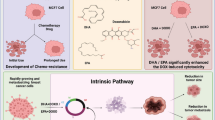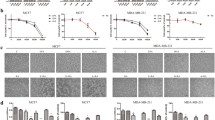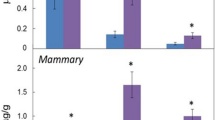Abstract
Omega-3 polyunsaturated fatty acids (PUFAs) exert an anticancer effect by affecting multiple cellular mechanisms leading to inhibition of proliferation and induction of apoptosis. It is well known that breast cancer comprises distinct molecular subtypes which differ in their responsiveness to therapeutic and preventive agents. We tested the hypothesis that n-3FA may preferentially affect triple-negative breast cancer cells for which no targeted intervention is presently available. The in vitro antiproliferative effects of n-3 PUFA docosahexaenoic acid (DHA) and its metabolite, 4-OH-DHA as well as its putative metabolite 4-OXO-DHA, were tested in five triple-negative human basal breast cell lines at different stages of transformation (MCF-10F, trMCF, bsMCF, MDA-MB-231, and BT-549) and three luminal breast cancer cell lines (MCF-7, T-47D, and SK-BR-3). Cell proliferation was measured with the tetrazolium MTT (3-(4,5-dimethylthiazolyl-2)-2,5-diphenyltetrazolium bromide) assay. DHA and its oxidized derivatives significantly inhibited cell proliferation (20–90% reduction) of both basal and luminal breast cancer cell lines. The inhibitory effect was more pronounced on triple-negative basal breast cancer cell lines as compared to luminal breast cancer cell lines after 4-OXO-DHA treatment. Our data provide novel information regarding the preferential antitumor effect of oxidized derivatives of DHA on basal type breast cancer.




Similar content being viewed by others
References
Anti M, Marra G, Armelao F, Bartoli GM, Ficarelli R, Percesepe A, De Vitis I, Maria G, Sofo L, Rapaccini GL et al (1992) Effect of omega-3 fatty acids on rectal mucosal cell proliferation in subjects at risk for colon cancer. Gastroenterology 103:883–891
Berquin IM, Edwards IJ, Chen YQ (2008) Multi-targeted therapy of cancer by omega-3 fatty acids. Cancer Lett 269:363–377
Berquin IM, Min Y, Wu R, Wu J, Perry D, Cline JM, Thomas MJ, Thornburg T, Kulik G, Smith A, Edwards IJ, D’Agostino R, Zhang H, Wu H, Kang JX, Chen YQ (2007) Modulation of prostate cancer genetic risk by omega-3 and omega-6 fatty acids. J Clin Invest 117:1866–1875
Blanckaert V, Ulmann L, Mimouni V, Antol J, Brancquart L, Chenais B (2010) Docosahexaenoic acid intake decreases proliferation, increases apoptosis and decreases the invasive potential of the human breast carcinoma cell line MDA-MB-231. Int J Oncol 36:737–742
Carroll KK, Braden LM (1984) Dietary fat and mammary carcinogenesis. Nutr Cancer 6:254–259
Chajes V, Hulten K, Van Kappel AL, Winkvist A, Kaaks R, Hallmans G, Lenner P, Riboli E (1999) Fatty-acid composition in serum phospholipids and risk of breast cancer: an incident case-control study in Sweden. Int J Cancer 83:585–590
Chapkin RS, McMurray DN, Lupton JR (2007) Colon cancer, fatty acids and anti-inflammatory compounds. Curr Opin Gastroenterol 23:48–54
Gago-Dominguez M, Yuan JM, Sun CL, Lee HP, Yu MC (2003) Opposing effects of dietary n-3 and n-6 fatty acids on mammary carcinogenesis: the Singapore Chinese Health Study. Br J Cancer 89:1686–1692
Holmes MD, Hunter DJ, Colditz GA, Stampfer MJ, Hankinson SE, Speizer FE, Rosner B, Willett WC (1999) Association of dietary intake of fat and fatty acids with risk of breast cancer. JAMA 281:914–920
Huang Y, Fernandez SV, Goodwin S, Russo PA, Russo IH, Sutter TR, Russo J (2007) Epithelial to mesenchymal transition in human breast epithelial cells transformed by 17beta-estradiol. Cancer Res 67:11147–11157
Itoh T, Fairall L, Amin K, Inaba Y, Szanto A, Balint BL, Nagy L, Yamamoto K, Schwabe JW (2008) Structural basis for the activation of PPARgamma by oxidized fatty acids. Nat Struct Mol Biol 15:924–931
Itoh T, Murota I, Yoshikai K, Yamada S, Yamamoto K (2006) Synthesis of docosahexaenoic acid derivatives designed as novel PPARgamma agonists and antidiabetic agents. Bioorg Med Chem 14:98–108
Kaizer L, Boyd NF, Kriukov V, Tritchler D (1989) Fish consumption and breast cancer risk: an ecological study. Nutr Cancer 12:61–68
Kang KS, Wang P, Yamabe N, Fukui M, Jay T, Zhu BT (2010) Docosahexaenoic acid induces apoptosis in MCF-7 cells in vitro and in vivo via reactive oxygen species formation and caspase 8 activation. PLoS One 5:e10296
Kim S, Sandler DP, Galanko J, Martin C, Sandler RS (2010) Intake of polyunsaturated fatty acids and distal large bowel cancer risk in whites and African Americans. Am J Epidemiol 171:969–979
Larsson SC, Kumlin M, Ingelman-Sundberg M, Wolk A (2004) Dietary long-chain n-3 fatty acids for the prevention of cancer: a review of potential mechanisms. Am J Clin Nutr 79:935–945
Liu YE, Pu W, Wang J, Kang JX, Shi YE (2007) Activation of Stat5 and induction of a pregnancy-like mammary gland differentiation by eicosapentaenoic and docosapentaenoic omega-3 fatty acids. FEBS J 274:3351–3362
Mosmann T (1983) Rapid colorimetric assay for cellular growth and survival: application to proliferation and cytotoxicity assays. J Immunol Methods 65:55–63
Murphy RA, Mourtzakis M, Mazurak VC (2012) n-3 polyunsaturated fatty acids: the potential role for supplementation in cancer. Curr Opin Clin Nutr Metab Care 15:246–251
Noguchi M, Minami M, Yagasaki R, Kinoshita K, Earashi M, Kitagawa H, Taniya T, Miyazaki I (1997) Chemoprevention of DMBA-induced mammary carcinogenesis in rats by low-dose EPA and DHA. Br J Cancer 75:348–353
Rahman MM, Veigas JM, Williams PJ, Fernandes G (2013) DHA is a more potent inhibitor of breast cancer metastasis to bone and related osteolysis than EPA. Breast Cancer Res Treat 141:341–352
Ravacci GR, Brentani MM, Tortelli T Jr, Torrinhas RS, Saldanha T, Torres EA, Waitzberg DL (2013) Lipid raft disruption by docosahexaenoic acid induces apoptosis in transformed human mammary luminal epithelial cells harboring HER-2 overexpression. J Nutr Biochem 24:505–515
Rovito D, Giordano C, Vizza D, Plastina P, Barone I, Casaburi I, Lanzino M, De Amicis F, Sisci D, Mauro L, Aquila S, Catalano S, Bonofiglio D, Ando S (2013) Omega-3 PUFA ethanolamides DHEA and EPEA induce autophagy through PPARgamma activation in MCF-7 breast cancer cells. J Cell Physiol 228:1314–1322
Russo J, Balogh GA, Chen J, Fernandez SV, Fernbaugh R, Heulings R, Mailo DA, Moral R, Russo PA, Sheriff F, Vanegas JE, Wang R, Russo IH (2006a) The concept of stem cell in the mammary gland and its implication in morphogenesis, cancer and prevention. Front Biosci 11:151–172
Russo J, Fernandez SV, Russo PA, Fernbaugh R, Sheriff FS, Lareef HM, Garber J, Russo IH (2006b) 17-Beta-estradiol induces transformation and tumorigenesis in human breast epithelial cells. FASEB J 20:1622–1634
Russo J, Hasan Lareef M, Balogh G, Guo S, Russo IH (2003) Estrogen and its metabolites are carcinogenic agents in human breast epithelial cells. J Steroid Biochem Mol Biol 87:1–25
Sapieha P, Stahl A, Chen J, Seaward MR, Willett KL, Krah NM, Dennison RJ, Connor KM, Aderman CM, Liclican E, Carughi A, Perelman D, Kanaoka Y, Sangiovanni JP, Gronert K, Smith LE (2011) 5-Lipoxygenase metabolite 4-HDHA is a mediator of the antiangiogenic effect of omega-3 polyunsaturated fatty acids. Sci Transl Med 3:69ra12
Schley PD, Brindley DN, Field CJ (2007) (n-3) PUFA alter raft lipid composition and decrease epidermal growth factor receptor levels in lipid rafts of human breast cancer cells. J Nutr 137:548–553
Signori C, DuBrock C, Richie JP, Prokopczyk B, Demers LM, Hamilton C, Hartman TJ, Liao J, El-Bayoumy K, Manni A (2012) Administration of omega-3 fatty acids and Raloxifene to women at high risk of breast cancer: interim feasibility and biomarkers analysis from a clinical trial. Eur J Clin Nutr 66:878–884
Signori C, El-Bayoumy K, Russo J, Thompson HJ, Richie JP, Hartman TJ, Manni A (2011) Chemoprevention of breast cancer by fish oil in preclinical models: trials and tribulations. Cancer Res 71:6091–6096
Soule HD, Maloney TM, Wolman SR, Peterson WD Jr, Brenz R, McGrath CM, Russo J, Pauley RJ, Jones RF, Brooks SC (1990) Isolation and characterization of a spontaneously immortalized human breast epithelial cell line, MCF-10. Cancer Res 50:6075–6086
Stripp C, Overvad K, Christensen J, Thomsen BL, Olsen A, Moller S, Tjonneland A (2003) Fish intake is positively associated with breast cancer incidence rate. J Nutr 133:3664–3669
Sun H, Berquin IM, Owens RT, O’Flaherty JT, Edwards IJ (2008) Peroxisome proliferator-activated receptor gamma-mediated up-regulation of syndecan-1 by n-3 fatty acids promotes apoptosis of human breast cancer cells. Cancer Res 68:2912–2919
Vatten LJ, Solvoll K, Loken EB (1990) Frequency of meat and fish intake and risk of breast cancer in a prospective study of 14,500 Norwegian women. Int J Cancer 46:12–15
Yee LD, Lester JL, Cole RM, Richardson JR, Hsu JC, Li Y, Lehman A, Belury MA, Clinton SK (2010) Omega-3 fatty acid supplements in women at high risk of breast cancer have dose-dependent effects on breast adipose tissue fatty acid composition. Am J Clin Nutr 91:1185–1194
Yuri T, Danbara N, Tsujita-Kyutoku M, Fukunaga K, Takada H, Inoue Y, Hada T, Tsubura A (2003) Dietary docosahexaenoic acid suppresses N-methyl-N-nitrosourea-induced mammary carcinogenesis in rats more effectively than eicosapentaenoic acid. Nutr Cancer 45:211–217
Zhang H, Zhou L, Shi W, Song N, Yu K, Gu Y (2012) A mechanism underlying the effects of polyunsaturated fatty acids on breast cancer. Int J Mol Med 30:487–494
Acknowledgments
This project was supported by Komen Foundation grant KG081632, NCI core grant CA06927, and an appropriation from the Commonwealth of Pennsylvania. We also acknowledge the use of the tissue culture facility at Fox Chase Cancer Center
Author information
Authors and Affiliations
Corresponding author
Additional information
Editor: T. Okamoto
Rights and permissions
About this article
Cite this article
Pogash, T.J., El-Bayoumy, K., Amin, S. et al. Oxidized derivative of docosahexaenoic acid preferentially inhibit cell proliferation in triple negative over luminal breast cancer cells. In Vitro Cell.Dev.Biol.-Animal 51, 121–127 (2015). https://doi.org/10.1007/s11626-014-9822-6
Received:
Accepted:
Published:
Issue Date:
DOI: https://doi.org/10.1007/s11626-014-9822-6




